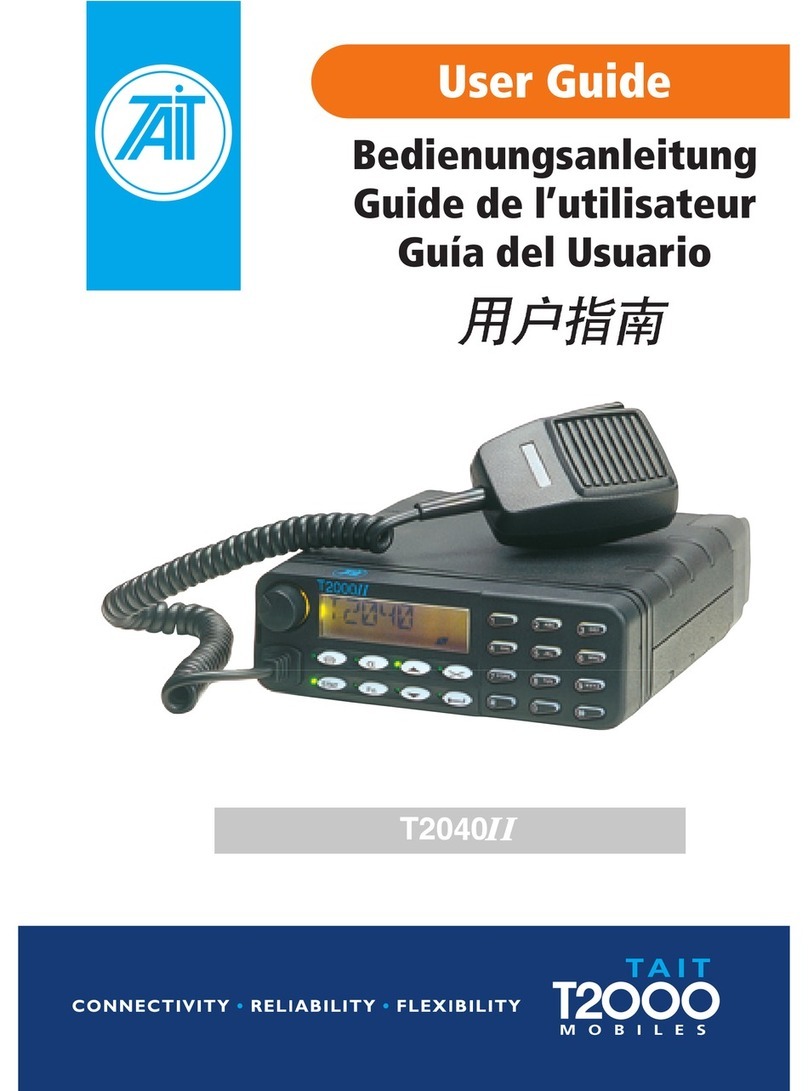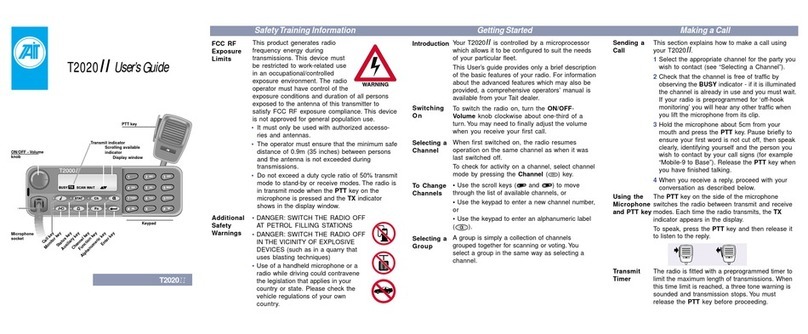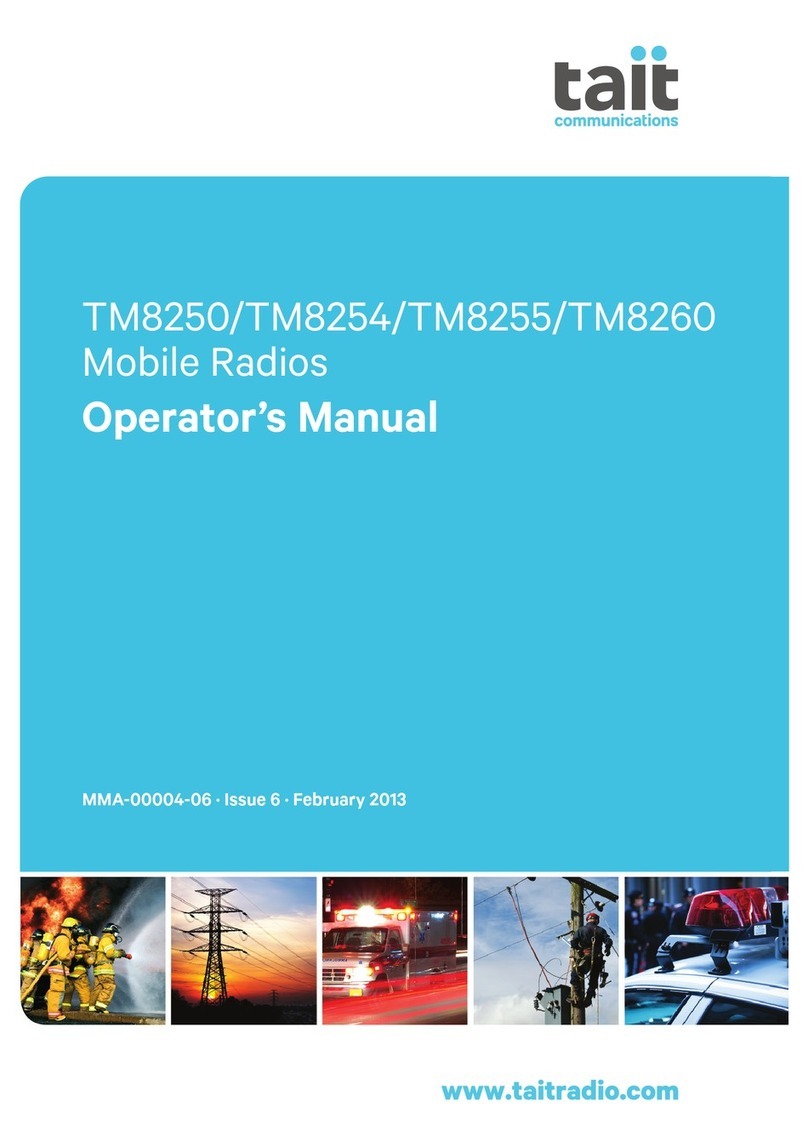
MMA-00004-05 Issue 5
© Tait Electronics Limited March 2008. All rights reserved. 3
Directive 1999/5/EC
Declaration of Conformity
da Dansk
Undertegnede Tait Electronics Limited
erklærer herved, at følgende udstyr
TMAA4C, TMAB1C, TMAH5C & TMAC0C
overholder de væsentlige krav og øvrige rele-
vante krav i direktiv 1999/5/EF.
Se endvidere:
http://eudocs.taitworld.com/
de Deutsch
Hiermit erklärt Tait Electronics Limited die
Übereinstimmung der Geräte TMAA4C,
TMAB1C, TMAH5C & TMAC0C mit den
grundlegenden Anforderungen und den
anderen relevanten Festlegungen der
Richtlinie 1999/5/EG.
Siehe auch: http://eudocs.taitworld.com/
el Ελληνικός
Με την παρουσα Tait Electronics Limited
δηλωνει οτι TMAA4C, TMAB1C, TMAH5C
& TMAC0C συμμορφωνεται προσ τισ
ουσιωδεισ απαιτησεισ και τισ λοιπεσ
σχετικεσ διαταξεισ τησ οδηγιασ
1999/5/ΕΚ.
βλέπε και: http://eudocs.taitworld.com/
en English
Tait Electronics Limited declares that this
TMAA4C, TMAB1C, TMAH5C &
TMAC0C complies with the essential
requirements and other relevant provi-
sions of Directive 1999/5/EC.
See also: http://eudocs.taitworld.com/
es Español
Por medio de la presente Tait Electronics
Limited declara que el TMAA4C,
TMAB1C, TMAH5C & TMAC0C cumple
con los requisitos esenciales y cualesqui-
era otras disposiciones aplicables o exigi-
bles de la Directiva 1999/5/CE. Vease
también: http://eudocs.taitworld.com/
fi Suomi
Tait Electronics Limited vakuuttaa täten
että TMAA4C, TMAB1C, TMAH5C &
TMAC0C tyyppinen laite on direktiivin
1999/5/EY oleellisten vaatimusten ja sitä
koskevien direktiivin muiden ehtojen
mukainen.
Katso: http://eudocs.taitworld.com/
fr Français
Par la présente, Tait Electronics Limited
déclare que les appareils TMAA4C,
TMAB1C, TMAH5C & TMAC0C sont
conformes aux exigences essentielles et
aux autres dispositions pertinentes de la
directive 1999/5/CE.
Voir aussi: http://eudocs.taitworld.com/
it Italiano
Con la presente Tait Electronics Limited
dichiara che questo TMAA4C, TMAB1C,
TMAH5C & TMAC0C è conforme ai
requisiti essenziali ed alle altre dispo-
sizioni pertinenti stabilite dalla direttiva
1999/5/CE.
Vedi anche: http://eudocs.taitworld.com/
nl Nederlands
Hierbij verklaart Tait Electronics Limited
dat het toestel TMAA4C, TMAB1C,
TMAH5C & TMAC0C in overeenstem-
ming is met de essentiële eisen en de
andere relevante bepalingen van richtlijn
1999/5/ EG.
Zie ook: http://eudocs.taitworld.com/
pt Português
Tait Electronics Limited declara que este
TMAA4C, TMAB1C, TMAH5C &
TMAC0C está conforme com os requisi-
tos essenciais e outras provisões da
Directiva 1999/5/CE.
Veja também:
http://eudocs.taitworld.com/
sv Svensk
Härmed intygar Tait Electronics Limited
att denna TMAA4C, TMAB1C, TMAH5C
& TMAC0C står I överensstämmelse med
de väsentliga egenskapskrav och övriga
relevanta bestämmelser som framgår av
direktiv 1999/5/EG.
Se även: http://eudocs.taitworld.com/
































